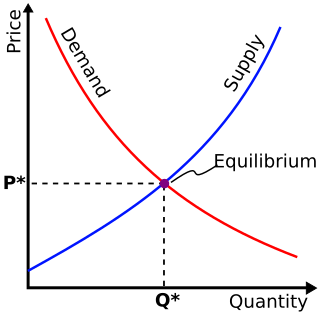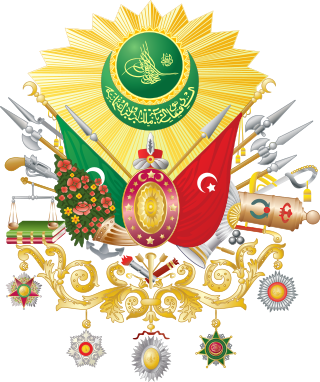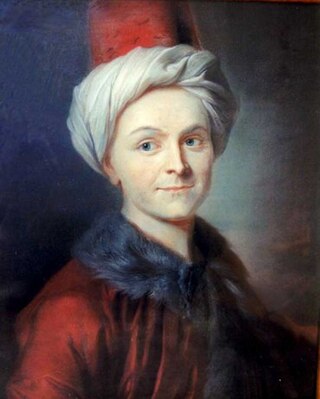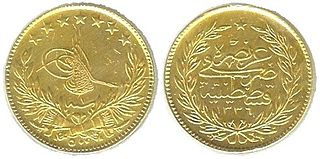Related Research Articles
Oka or OKA may refer to:
The oka, okka, or oke was an Ottoman measure of mass, equal to 400 dirhems. Its value varied, but it was standardized in the late empire as 1.2829 kilograms. 'Oka' is the most usual spelling today; 'oke' was the usual contemporary English spelling; 'okka' is the modern Turkish spelling, and is usually used in academic work about the Ottoman Empire.

The dirham, dirhem or drahm is a unit of currency and of mass. It is the name of the currencies of Morocco, the United Arab Emirates and Armenia, and is the name of a currency subdivision in Jordan, Libya, Qatar and Tajikistan. It was historically a silver coin.
The batman was a unit of mass used in the Ottoman Empire and among Turkic peoples of the Russian Empire. It has also been recorded as a unit of area in Uyghur-speaking regions of Central Asia. The name is Turkic, but was also sometimes used for the equivalent unit in Persia. The equivalent unit in British India was anglicized as the maund. The value of the batman varied considerably from place to place.

In economics, nominalvalue refers to value measured in terms of absolute money amounts, whereas real value is considered and measured against the actual goods or services for which it can be exchanged at a given time. Real value takes into account inflation and the value of an asset in relation to its purchasing power. In macroeconomics, the real gross domestic product compensates for inflation so economists can exclude inflation from growth figures, and see how much an economy actually grows. Nominal GDP would include inflation, and thus be higher.

The para was a former currency of the Ottoman Empire, Turkey, Egypt, Montenegro, Albania and Yugoslavia and is the current subunit, although rarely used, of the Serbian dinar.

Mohács is a town in Baranya County, Hungary, on the right bank of the Danube.

The Tulip Period, or Tulip Era, is a period in Ottoman history from the Treaty of Passarowitz on 21 July 1718 to the Patrona Halil Revolt on 28 September 1730. This was a relatively peaceful period, during which the Ottoman Empire began to orient itself outwards.
Gölpazarı is a town in Bilecik Province in the Marmara region of Turkey. It is the seat of Gölpazarı District. Its population is 5,723 (2021). The mayor is Hayri Suer (AKP).
The Russo-Crimean Wars were fought between the forces of the Tsardom of Russia and the Crimean Khanate during the 16th century over the region around the Volga River.
The poetry of the Ottoman Empire, or Ottoman Divan poetry, is little known outside modern Turkey, which forms the heartland of what was once the Ottoman Empire. It is, however, a rich and ancient poetic tradition that lasted for nearly 700 years, and one whose influence can still be felt in the modern Turkish poetic tradition.
The Ottoman Turkish alphabet is a version of the Perso-Arabic script used to write Ottoman Turkish until 1928, when it was replaced by the Latin-based modern Turkish alphabet.

Turquerie, or Turquoiserie, was the Turkish fashion in Western Europe from the 16th to 18th centuries for imitating aspects of Ottoman art and culture. Many different Western European countries were fascinated by the exotic and relatively unknown culture of the Ottoman ruling class, which was the center of the Ottoman Empire. This fashionable phenomenon became more popular through trading routes and increased diplomatic relationships between the Ottomans and the European nations, exemplified by the Franco-Ottoman alliance in 1715. Ambassadors and traders often returned home with tales of exotic places and souvenirs of their adventures.

The postal history of Turkey and its predecessor state, the Ottoman Empire, dates to the 18th century when foreign countries maintained courier services through their consular offices in the Empire. Although delayed in the development of its own postal service, in 1863 the Ottoman Empire became the second independent country in Asia to issue adhesive postage stamps, and in 1875, it became a founding member of the General Postal Union, soon to become the Universal Postal Union. The Ottoman Empire became the Republic of Turkey in 1923, and in the following years, its postal service became more modernized and efficient and its postage stamps expertly designed and manufactured.

The steppe and forest-steppe of Ukraine and southern Russia, traditionally held by pastoral nomads, provided agricultural opportunities. States that were able to settle the land with tax-paying peasants could significantly increase their power. From 1500 to 1800, this region came under Russian control.

The pound or lira was the currency of the Ottoman Empire from 1844 until 1927, when it was replaced by the Turkish lira. Although the Ottoman Empire was abolished in 1922, the Ottoman lira remained in circulation until the end of 1927, as the Republic of Turkey that succeeded it was not in a position to issue its own banknotes yet in its early years.
The gümrük resmi was a customs charge, or tax, in the Ottoman Empire. In modern-day Turkey the term continues to be in use: Gümrük vergi ve resimleri.
Sürsat was a form of food requisitioning with price controls, used by the Ottoman Empire to provide consumables for its armed forces. It was related to nüzül; sürsat was initially an obligation for the public to provide food and other supplies at a pre-fixed price which was unlikely to be favourable, or might even be merely symbolic. Istira was basically the same obligation, but supposedly at market price. Over time, nüzül, sürsat, and istira were all transformed into extraordinary cash taxes on people living near the route travelled by the army.
Ottoman Sign Language, also known as Seraglio Sign Language or Harem Sign Language, was a deaf sign language of the Ottoman court in Istanbul. Nothing is known of it directly, but it is reported that it could communicate ideas of any complexity, and that it was passed on to the young through fables, histories, and scripture.
Oka was a town of ancient Bithynia, inhabited in Roman times. The name does not occur among ancient authors but is inferred from epigraphic and other evidence.
References
- Diran Kélékian, Dictionnaire Turc-Français, Constantinople: Imprimerie Mihran, 1911.
- A.D. Alderson and Fahir İz, The Concise Oxford Turkish Dictionary, 1959.
- Halil İnalcık, Donald Quataert, An Economic and Social History of the Ottoman Empire, 1300-1914, Cambridge University Press, 1997. ISBN 0-521-57455-2. Has extensive tables of values of the kile at various times and places.